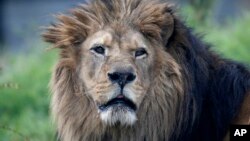Conservationists are breeding lions in the Southern African nation of Zimbabwe. The wildlife experts hope to increase the lion population to keep the great cats from disappearing.
In some areas, lions and human beings are competing for control of land. Researchers believe something must be done quickly to save the animals.
Today we take you to the Antelope Park Farm in Gweru, Zimbabwe. The main business here is lion breeding.
The African Lion and Environmental Research Trust has more than 100 lions in its breeding program. The trust is known by the name ALERT.
Gary Jones heads the Antelope Park Farm. He says ALERT has become involved because of a sharp drop in the number of lions. His group believes this has been caused mostly by humans. There are more people moving to this area every year. The lions have less land on which to live.
“The wild population of lion has plummeted from about 250 to 260,000, 30 to 35 years ago to a current estimate ranging between 18 and 30 or 32,000. So you can see the numbers have declined horribly. It comes through human population growth. So the future for the lion is looking very bleak at the moment as humans encroach into their natural environment as our population expands.”
Antelope Park Farm is one of two sites ALERT operates in Zimbabwe. Another area is in Zambia. Gary Jones says the decrease in the lion population affects the whole environment. He adds that other African nations are also seeing the disastrous effects of this.
“There are countries, particularly in central and North Africa, where the lion population has reached a critical level. Burundi, for instance, do not have lions whatsoever in their national parks. They are very, very desperate to have lions reintroduced back into their national parks because (when) you take the apex predator (lion) out of the equation, and suddenly you get all funny things happening with the balance of nature. You get overstocking of these prey species. You get disease coming through into these populations of prey species. That is exactly what is happening in Burundi.”
The United Nations’ Food and Agriculture Organization says wild animals are threatened when farmers try to protect their plants or animals.
Rene Czudek works for the UN agency. Mr. Czudek is the FAO official responsible for wildlife and forestry in southern Africa. He says his organization has come up with a human-wildlife tool kit that some countries are using to reduce conflict between humans and wildlife.
“So then we are trying to explain to the people what is the behavior of lions, how do they act. So it is a kind of, you know, building capacity of people to assess the situation, land use planning, not to put their fields just on pathway of elephants or a corridor. In fact, the human-wildlife tool kit is a kind of instrument that extension workers can use with the communities -- explain to them the behavior of wildlife, … then show them what are the risky behaviors, how they should, you know, plan for their fields.”
By providing information, the FAO hopes the conflict between humans and wildlife can be reduced, and that the threatened species can grow again.
I’m Jim Tedder.
This report was based on a story from Sebastian Mhofu in Gweru, Zimbabwe. Jim Tedder adapted it for Learning English. George Grow was the editor.
_______________________________________________________________
Words in This Story
breeding - v. sexually reproducing animals or plants
population - n. all the people, animals or things in a place, city or country
drop - n. the process of decreasing; reduction





